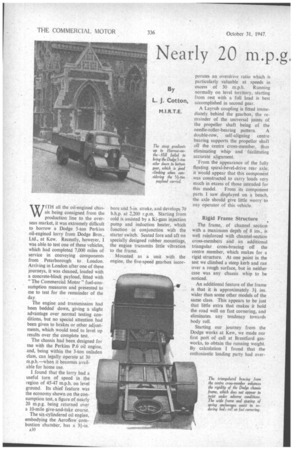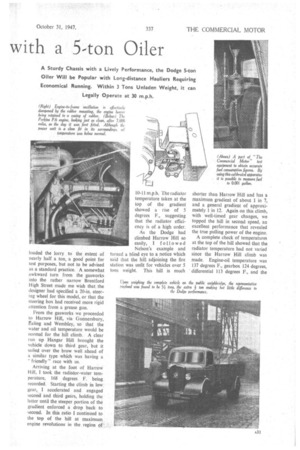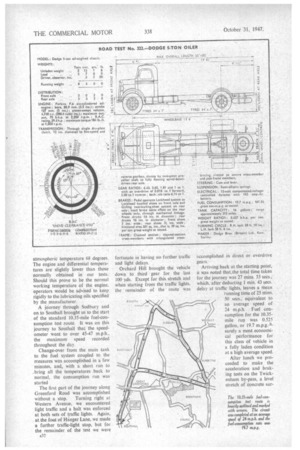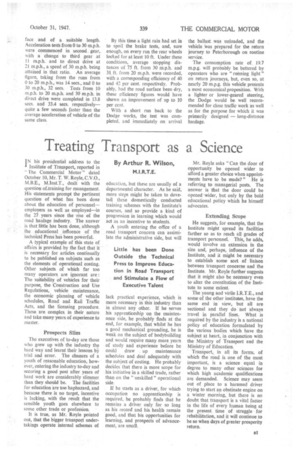Nearly 20 m p.g, with a 5-ton Oiler
Page 32

Page 33

Page 34

Page 35

If you've noticed an error in this article please click here to report it so we can fix it.
A Sturdy Chassis with a Lively Performance, the Dodge 5-ton Oiler Will be Popular with Long-distance Hauliers Requiring Economical Running. Within 3 Tons Unladen Weight, it can Legally Operate at 30 m.p.h.
By
L. J. Cotton, m.i.R.T.E.
WITH all the oil-engined chassis being consigned from the production line to the overseas market, it was extremely difficult to borrow a Dodge 5-ton Perkins oil-engined lorry from Dodge Bros., Ltd., at Kew. Recently, however, I was able to test one of these vehicles, which had completed 7,000 miles of service in conveying components from Peterborough to . London. Arriving in London after one of these journeys, it was cleaned, loaded with a concrete-block payload, fitted with "The Commercial Motor" fuel-consumption measures and presented to me to test for the remainder of the day The engine and transmission had been bedded down, giving a slight advantage over normal testing conditions, but no special attention had been given to brakes or other.adjustments, which would tend to level up results over the complete test.
The chassis had been designed for use with the Perkins P.6 oil engine, and, being within the 3-ton unladen class, can legally operate at 30 • • m.p.h.—when it becomes available for home use.
I found that the lorry had a useful turn of speed in the region of 45-47 m.p.h. on level ground. Its chief feature was the economy shown on the consumption test, a figure of nearly 20 m.p.g. being returned over a 10-mile Give-and-take course. The six-cylindered oil engine, embodying the Aeroflow'combustion chamber, has a 3A-in.
A30 bore and 5-in, stroke, and develops 70 b.h.p. at 2,200 r,p.m. Starting from cold is assisted by a Ki-gass injection pump and induction heater, which function in conjunction with the starter switch. Seated fore and aft on specially designed rubber mountings, the engine transmits little vibration to the frame.
Mounted as a unit with the engine, the five-speed gearbox incor porates an overdrive ratio which is particularly valuable at speeds in excess of 30 m.p.h. Running normally on level territory, starting from rest with a full load is best accomplished in second gear.
A Layrub coupling is fitted immediately behind the gearbox, the remainder of the universal joints of the propeller shaft being of the needle-roller-bearing pattern. A double-row, self-aligning centre bearing supports the propeller shaft off the centre cross-member, thus eliminating whip and facilitating accurate alignment.
'From the appearance of the fully floating spiral-bevel-drive rear axle, it would appear that this component was constructed to carry loads very much in excess of those intended for this model. From its component parts I saw displayed on a bench, the axle should give little worry to any operator of this vehicle.
Rigid Frame Structure
The frame, of channel. section with a maximum depth of 8 ins., is well reinforced with channel-section cross-members and an additional triangular cross-bracing off the centre member, which makes for a rigid structure. At one point in the test we climbed a steep kerb and ran over a rough surface, but in neither case was any chassis whip to be noticed. .
An additional feature of the frame is that it is approximately 31 ins. wider than some other models of the same class. This appears to be just that little extra that makes it hold the road well on fast cornering, and eliminates any tendency towards body roll.
Starting our journey from the Dodge works at Kew, we made our first port of call at Brentford gasworks, to obtain the running weight. By calculation I found that the enthusiastic loading party had over loaded the lorry, to the extent of nearly half a ton, a good point for test purposes, but not to be advised as a standard practice. A somewhat awkward torn from the gasworks into the rather narrow Brentford High Street made me wish that the designer had specified a 20-in, steering wheel for this model, or that the steering box had received more rigid attention from a grease gun.
From the gasworks we proceeded to Harrow Hill, via Gunnersbury, Ealing and Wembley, so that the water and oil temperature would be normal for the hill climb. A clear run • up Hangar Hill brought the vehicle down to third gear, but it sailed over the brow well ahead of a similar type which was having a
friendly race with us.
Arriving at the foot of Harrow Hill, I took the radiator-water temperature, 168 degrees F. being recorded. Starting the climb in low gear, I accelerated and engaged second and third gears, holding the latter until the steeper portion of the gradient enforced a drop back to second. In this ratio I continued to the top of the hill at maximum engine revolutions in the region of
10-11 m.p.h. The radiator temperature taken at the top of the gradient showed a rise of 5 degrees F., suggesting that the radiator efficiency is of a high order.
As the Dodge had climbed Harrow Hill so easily, I followed Nelson's example and turned a blind eye to a notice which said that the hill adjoining the fire station was unfit for vehicles over 5 tons weight. This hill is much
shorter than Harrow Hill and has a maximum gradient of about 1 in 7, and a general gradient of approximately 1 in 12. Again on this climb, with well-timed gear changes, we topped the hill in second speed, an excellent performance that revealed the true pulling power of the engine.
A complete check of temperatures at the top of the hill showed that the radiator temperature had not varied since the Harrow Hill climb was made. Engine-oil temperature was 137 degrees F., gearbox 124 degrees, differential 113 degrees F., and the atmospheric temperature 68 degrees. The engine and differential temperatures are slightly lower than those normally obtained in our tests. Should this prove to be the normal working temperature of the engine, operators would be advised to keep rigidly to the lubricating oils specified by the manufacturer.
A journey through Sudbury and on to Southall brought us to the start of the standard 10.35-mile fuel-consumption test route. It was on this journey to Southall that the speedometer went to over 45-47 m.p.h., the maximum speed recorded throughout the day.
Change-over from the main tank to the fuel system coupled to the measures was accomplished in a few minutes, and, with a short run to .bring all the temperatures back to normal, the consumption run was started The first part of the journey along Greenford Road was accomplished without a stop. Turning right at Western Avenue, we encountered light traffic and a halt was enforced at both sets of traffic lights. Again. at the foot of Hanger Lane, we made a further traffic-light stop, but for the remainder of the test we were fortunate in having no further traffic and light delays.
Orchard Hill brought the vehicle down to third gear for the last 100 yds. Except for this stretch and when starting from the traffic lights, the remainder of the route was accomplished in direct or overdrive gears.
Arriving back at the starting point, it w,as noted that,the total time taken for the journey was 27 mins. 33 sccs., which, after deducting 1 min. 43 secs. delay at traffic lights, leaves a mean running time of 25 mins. 50 secs., equivalent to an average speed of 24 m.p.h. Fuel consumption for the 10,35mile run was 0.525 gallon, or 19.7 mpg.-2surely a most economical performance for this class of vehicle in a fully laden condition at a high average speed.
After lunch we proceeded to make the acceleration and braking tests on the Twickenham by-pass, a level stretch of concrete sur
face and of a suitable length. Acceleration tests from 0 to 30 m.p.h. were commenced in second gear, with a change to third gear at 11 m.p.h. and to direct drive at 21 a speed of 30 m.p.h. being attained in that ratio. An average figure, taking from the runs from 0 to 20 m.p.h., was 14 secs., and 0 to 30 m.p.h., 32 secs. Tests from 10 m.p.h. to 20 m.p.h. and 30 m.p.h. in direct drive were completed in 13.8 secs. and 33.4 sees. respectively— quite a few seconds faster than the average acceleration of vehicle of the same class. By this time a light rain had set in to spoil the brake tests, and, sure enough, on every run the rear wheels locked for at least 10 ft. Under these conditions, average stopping distances of 75 ft. from 30 m.p.h. and 31 ft. from 20 m.p.h. were recorded, with a corresponding efficiency of 40 and 42 per cent. respectively. Probably, had the road surface been dry, these efficiency figures would have shown an improvement of up to ID per cent.
With a short run back to the Dodge works, the test was completed, and immediately on arrival the ballast was unloaded, and the vehicle Was prepared for the return journey, to Peterborough on routine service.
The consumption rate of 19.7 m.p.g. will probably be bettered by operators who are "running light" on return journeys, but, even so, at nearly 20 m.p.g. this vehicle presents a most economical proposition. With a lighter or lower-geared steering, the Dodge would be well recommended for close trafficwork as. well as for the purpose for which it was primarily designed — long-distance haulage.












































































